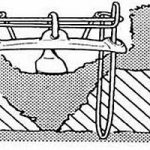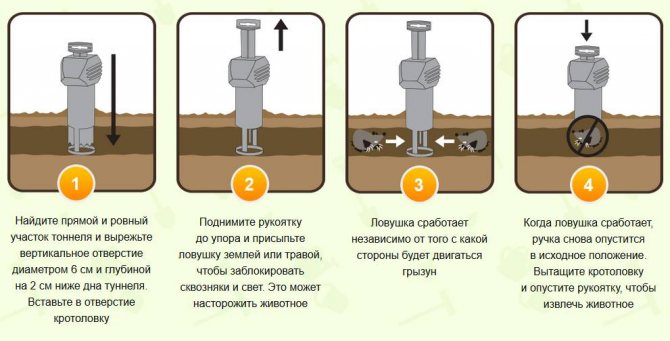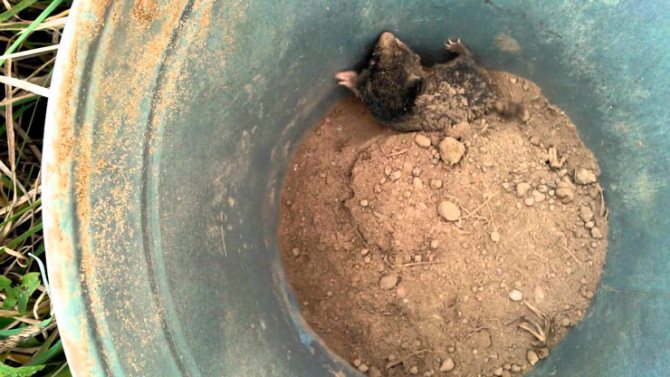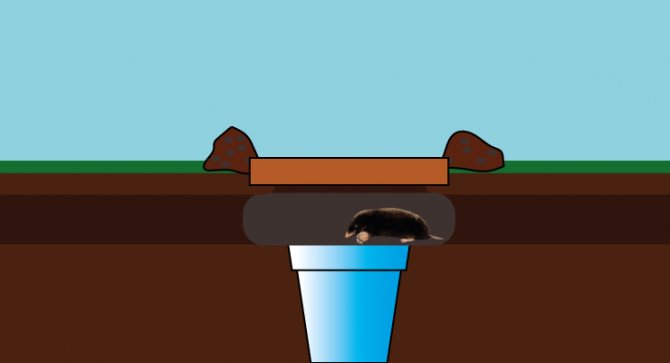In the garden, you can find many different pests that you always have to fight with. However, with the appearance of moles on the garden plot, the situation in the garden becomes simply unbearable and there is a risk of crop loss or leads to a deterioration in the appearance of the lawn. Moles are predatory representatives of underground mammals that can be found throughout Eurasia.
Moles are constantly in search of food for their food and need various worms, spiders, insect larvae and slugs. When searching for food, the "blind" most often damage the roots of plants not on purpose, but this leads to the death of the planted crops. It is for such reasons that gardeners and gardeners begin to look for options to combat the "blind".
The harm and benefits of moles
In appearance, they appear to be completely harmless underground animals with large paws, designed for only one action - digging deep and long passages underground. However, for owners of gardens and summer cottages, the arrival of even one mole seems to be a disaster. Moles feed on earthworms, larvae and insects, including pests. In addition, they are beneficial by improving the aeration of the soil and filling it with air.
However, building their underground multi-meter communications, moles undermine plants and cut off their roots, which leads to the death of a large number of plantings. Therefore, to save the garden, you have to deal with the question of how to drive moles out of the site.
General information
In fact, the mole is a harmless animal. Its appearance is a bit similar to that of a rat. Moles live exclusively underground. It should be borne in mind that they do not go into hibernation. Young moles in search of new housing and food can move quite long distances - several kilometers underground. Animals eat:
- Beetles.
- Butterflies.
- Larvae.
- Worms.
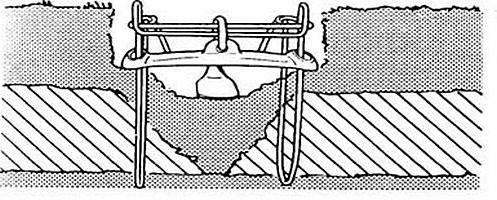
Removing moles from the garden
For many years of fighting moles, gardeners and truck farmers have come up with and tried many ways.
All methods of getting rid of "underground guests" are divided into 3 types:
- scaring away moles from the territory of the garden;
- folk methods of struggle;
- chemical and mechanical methods of pest control.
Scaring away moles from the garden


Acoustic devices for scaring away moles from the garden
For those who prefer humane means of struggle, various methods of scaring animals from the site are suitable, based on the creation of discomfort for their existence, affecting hearing and smell. After all, moles do not like loud sounds and harsh unpleasant odors.
The following folk acoustic devices will allow the mole to be driven out of the garden:
- Burying empty glass bottles around the perimeter of the site at an angle of 45 ° C to the ground: when the wind hits them, a humming sound is produced, which transmits vibration into the soil and scares away "underground" guests away from the garden.
- Another option for a homemade repeller is to hang empty cans on poles along the border of the plot, which also begin to "rattle" from gusts of wind.
- Similarly, various rattles are made of tin or turntables from plastic bottles, which also make noise and scare away the animals.
The disadvantages of such methods: in calm weather, the devices do not work, moreover, their action is limited geographically. Therefore, to protect the entire site, you have to install a lot of turntables and ratchets, and this may end up with the "escape" of the owners.
Types of traps
If farmers are interested in how to trap a mole, there are a couple of species to consider. These methods are less humane than the above, but at the same time they are quite effective.
It should be noted that scarers operate constantly and are designed to drive away all moles that want to settle on your site. Traps are usually triggered on one individual.
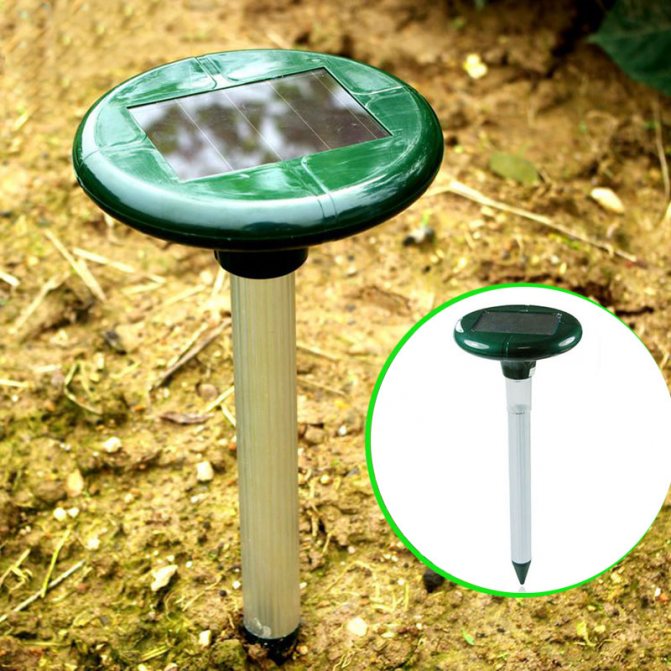

One of the simplest traps that you can use in your garden is hook fishing. It is necessary to take triple hooks, and lay them out in a previously dug mole. The hooks are tied with a thin wire and placed on both sides in the passage itself. When the animal climbs into the hole, it will catch on to them, and may get stuck. The wire must be fixed on a stationary structure, and you can also make an impromptu "bell" from a tin can and small pebbles. As soon as the mole is caught, you will immediately hear about it.
Here are two more types of homemade traps.
"Silent Hunt"
This method of catching moles has existed for a very long time. At one time, it was tested by the menagerie workers. They found the place where the mole comes out, and then waited for the animal to come and start digging in this place. They could dig a little mink so that the mole would come to close it up, as he does not like it when the air walks in his moves.
As soon as the workers saw that the mole began to bury the exit, they drove a bayonet shovel into the ground across their passage, and then dug it along with the soil, reaching out. Sometimes it was necessary to wait long enough, but it was necessary to act quickly when a pest appeared.
"Pan" trap
This method is one of the most effective traps commonly used by farmers on their land. This is a fairly simple mole trap.
First you need to find approximately where the middle of the fresh move, which was made by the mole, is located. Then, breaking this passage, a pan is dug in below its level. The pot can be replaced with a glass bottle or other container with the same volume. The most important thing is that the container has smooth high walls. Then the hole needs to be covered with a small layer of turf, placing as many branches as possible so that a lot of earth does not fall into the container.
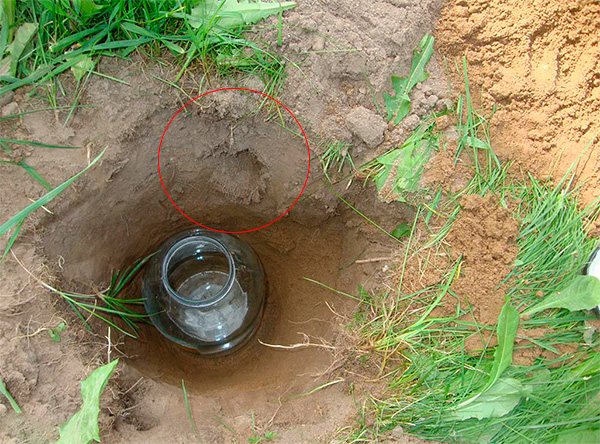

Moles move under the soil quickly enough, and such traps are not noticed. When they get into such containers, they will not be able to get out of there themselves. The captured animal can be released far beyond the boundaries of your possessions.
Traditional methods


Folk methods of struggle
Experienced gardeners use various smells of plants or substances, as well as mechanical methods to scare away moles:
- The most time-consuming method of preventing the appearance of moles in the garden: along the entire perimeter to a depth of at least 1 m, dig in a galvanized metal mesh with holes no more than 2x2 cm, that is, make complete isolation from all animals that move underground. The holes are left so that earthworms and beneficial insects can move.
- Planting odorous plants around the perimeter: legumes, daffodils, marigolds, onions, garlic, hazel grouse or euphorbia will scare off moles in this area. However, it should be borne in mind that some of them are poisonous to humans, and therefore pose a danger to children and pets.
- The use of various pungent substances: kerosene, naphthalene, castor oil, fuel oil, tar, vinegar, tobacco and red pepper.Liquids can be impregnated with tissue, which is then pushed into the mole passages, powders can be scattered over the area, etc. However, all these methods are ineffective, since odors evaporate quickly and their effect is short-lived.
On a note!
Some gardeners even use various spoiled foods to scare away the "diggers": rotten herring, rotten vegetables or rotten eggs. However, such smells can drive not only moles, but also people from their own area.
In reality, noise and unpleasant odors can scare away moles, but for a short time, which is why they are classified as ineffective means.
"Silent Hunt"
This method has been used for a very long time. The workers of the Gatchina menagerie resorted to him. Mole traps were not always at their disposal. As a rule, a small number of moles live in nurseries and flower gardens. Therefore, the workers used the simplest method: they armed themselves with iron shovels. It was necessary to watch for the animal in the place where molehills were formed. Then they waited until the animal began to throw the earth out. Since it was quite difficult to catch a mole, it was necessary to act quickly. The workers, when signs of movement in the burrow appeared, sharply thrust the shovel into the ground. It was necessary to do it across the course. Thus, the animal was thrown out. This method has now been improved.
Ready-made ultrasonic scarers


Ultrasonic scarers of moles from the garden
Special ultrasonic devices are also based on the principle of acoustic scaring, which are produced industrially, both Russian and foreign. They use ultrasonic waves that are inaudible to the human ear.
Installation on the site of acoustic devices Antikrot, Krotogon, EcoSniper, Cityitek, etc., which generate ultrasonic signals that notify the animals of danger, will force the "underground guests" to leave the territory of the garden.
The disadvantage of this method is the rather expensive equipment and the effect of ultrasound signals on pets, as well as the short-term action, because after turning off the device, all moles can return back.
How to catch an animal
Catching moles is not as easy as it might seem at first glance.


The most acceptable methods are:
- Calling a service dealing with the capture of blind diggers. With the help of smoke bombs and mole traps, experts will clear your site of pests, but they cannot give a guarantee that the situation will not repeat next year. In addition, such a call can significantly "hit the pocket" of the site owner.
- The use of scarers. It is worth noting that not all summer residents love this method, because homemade scarers create unpleasant noise not only for the mole, but also for the person. And ultrasonic repellents can stop working, and then there is a possibility of the return of moles.
- Use of industrial or homemade mole traps. Both types are quite effective and the results of their action are approximately the same. So, if you have some free time and your hands are "sharpened correctly", you can start making a mole trap yourself.
Of course, in human society there are representatives who advocate barbaric, killing methods of fighting moles, but it is much more correct, more humane, more civilized to lure the animal into a trap, save its life and, without crippling it, release it.
The only point that should be taken into account is that the mole is released at a distance of at least 1 km from its site, otherwise it is likely that it will soon return to its habitable place.
Mole extermination methods


Mole extermination methods
The list of ways how to get a mole out of the garden includes both mechanical and chemical means:
- The use of mousetraps or special mole traps, which are installed at the exit from the holes, for the destruction of moles, will allow you to catch a certain part of the pests, although the method is inhumane.
- Various poisonous baits and poisons will help to effectively remove moles from the summer cottage. They are laid out in burrows or on the territory of the site, the animals die after eating them. Poisoning drugs for moles are sold in gardening stores.
- You can make poison baits yourself from boiled wheat, to which a pesticide is added. The poison is spread throughout the entire site, buried in holes or underground to a depth of at least 15 cm.
- Filling underground passages with a large amount of water is a fairly popular method, however, it helps to lime moles only in a situation when they only recently came to the site and did not have time to build complex underground structures.
- Catching live moles in a jar or pan, which are dug into the underground passage. After getting into a 3-liter container, the animal cannot get upstairs.
- A pipe trap is made independently, for which a pipe of the same diameter as the hole is selected: doors are installed at its ends, which open only inward: once there, the animal will not be able to crawl back and dies.
- You can catch an animal with a fishing hook if you tie it to a sturdy wooden stick. For catching, the hook is lowered into the mole hole and waited until the "prey" is caught.
- The installation of electric mole rats, which kill animals with an electric shock, will reduce the number of moles, but this method is financially costly.
Interesting!
One of the "cardinal" methods even involves the use of tear gas sprayed from a can into the burrows of animals. However, it requires sophisticated protective equipment and is a hazard to plants and people.
When deciding how to remove a mole from the site, each owner has to choose among a variety of methods and methods the most necessary and effective, based on financial capabilities, laboriousness of operations and the complexity of manufacturing devices. Some people prefer to use only humane methods, others, driven to despair by the invasion of moles, are capable of drastic and murderous methods to get rid of "underground enemies" forever.
Prevention
The safest and most effective way to get rid of moles forever is prevention. Above, advice has already been given on how to protect the territory from them. Here are some more:


- in addition to the already mentioned slate and linoleum, a galvanized metal mesh dug to a depth of one meter gives a good result. For the fangs and claws of rodents, it is practically inaccessible. One drawback is that after a certain time, the rusted protection should be replaced with a new analogue;


- roofing material gives a good effect. The main condition is that in both cases it is necessary to ensure that the protection rises above the surface to a height of up to half a meter.
We use mole traps
In order to catch the animal in a trap, you first need to purchase several industrial mole traps in a specialized store. It is then very important to set the traps correctly for these small mammals.
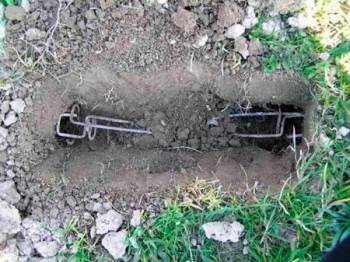

Algorithm of actions:
- They find the characteristic excavations that this animal leaves, with the help of a sharp metal rod they determine in which directions the passages diverge.
- The top layer of sod is removed and the device is placed on either side of the mink. This will ensure that the mole is caught regardless of its movement.
- After the trap is set, the removed sod is placed in place.
When the animal is caught, you will need to decide where to move the caught small pest.
If there are no funds or it is difficult to get to a specialized store, you can make mole traps with your own hands. But, nevertheless, we do not recommend making traps that can kill the animal, using fish hooks, wire, etc., but using live traps that will not harm a blind baby.

